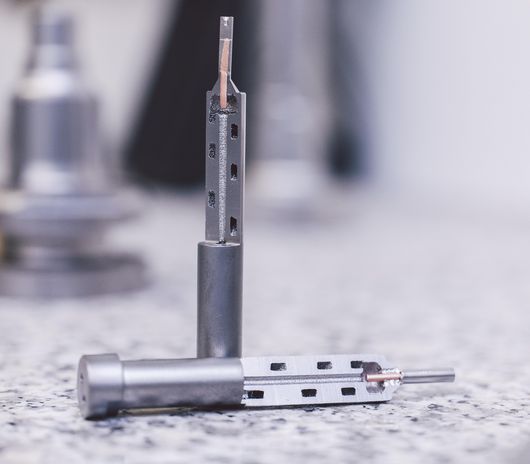The world largest manufacturers have already used 3D printing for some time, if not directly then through their supply chain partners. However, the value additive manufacturing (AM) provides is beginning to hit closer and closer to home—that is, within the conglomerates more directly. This includes one of the world’s largest consumer goods companies, Procter & Gamble (P&G) (NYSE: PG).
Ahead of a keynote address at Rapid.Tech 3D this May, Klaus Eimann, the Technical Director of Product and Packaging Innovation at P&G Germany, shared some of the ways in which his division relies on AM in a press release for the upcoming event. Applications include repairing tools and customizing items using metal 3D printing and hybrid techniques.
“With mold inserts in injection molding, it is often the case that material breaks away or wears down. These spots can be repaired effectively and quickly using additive technologies, such as laser deposition welding. There is no need to purchase or stock a spare part or even a spare tool. Instead, the repaired component is reused in a refined form, so to speak – with at least the same properties as a new part. This procedure reduces downtimes to a minimum,” Eimann said.
“With the additive approach, parts can be designed in such a way that the necessary properties are created specifically at the desired points. Combining additive and subtractive processes also offers potential for optimization. For example, a conventionally manufactured part can be additively hardened on a precisely defined area.”
According to an interview with Industry Arena, P&G has been using laser powder bed fusion (LPBF) and directed energy deposition (DED) from Trumpf since 2006. In particular, the company was able to improve production of Oral B electric toothbrushes with the technology. With LPBF, Eimann’s team was able to 3D print a 12mm-diameter steel pin for an injection molding tool. A spiral channel within the piece enabled quicker cooling times due to quicker heat dissipation. To further improve the tool, DED was used to weld a copper pin within the steel part, resulting in more even heat dissipation. Altogether, the hybrid part cut cycle times by seven seconds for a product that is made in batches of 100,000 daily.
The consumer giant has explored additive in various other ways throughout the years and throughout the world. In 2017, the multinational partnered with Canada Makes to 3D print a component for its manufacturing plant. Even beyond industrial applications, P&G has looked into the technology. For instance, it hosted a bioprinting competition in Singapore in 2015 and, in 2021, published a paper looking at the possibility of 3D printing patient-specific medications.
These are just the public details about what the company is doing with the technology and, as we have learned from the likes of Apple, we are surely only scratch the tip of the iceberg. This tracks with the projection from SmarTech Analysis that the general industry and tooling market for AM will be worth $5.48 billion in total revenue by 2029, according to its “Market Opportunities for Additive Manufacturing in the General Industry and Tooling Sector-2020-2029” report.
Eimann hinted at that much when he told the show promoters at Rapid.Tech 3D, “We already use 3D printing in component manufacturing and maintenance, as well as for customising products. But we still see huge potential for future applications.”
Attendees of the event will be able to learn more about Eimann’s own utilization of the technology at P&G, as well as how users from Porsche, Sauber, and the German-Emirati Institute take advantage of AM. The show will also include speakers from Autodesk, nFrontier, and Toolcraft, among others. To learn more about the event, taking place at Messe Efurt in Germany, May 17-19, 2022, visit the show website.
“We have an excellently functioning ecosystem of industry and research in Germany and Europe to drive 3D printing forward. At the moment, it is mainly large companies that are using this potential. But there are also many business opportunities here specifically for small and medium-sized companies. Unfortunately, these companies often lack the time to explore the possibilities. That’s why it’s good that there are events like Rapid.Tech 3D. The specialist conference and the exhibition provide a highly structured and focused insight into current AM developments,” Eimann said.
Subscribe to Our Email Newsletter
Stay up-to-date on all the latest news from the 3D printing industry and receive information and offers from third party vendors.
Print Services
Upload your 3D Models and get them printed quickly and efficiently.
You May Also Like
Consolidation in AM: How 2025 Is Shaping the Industry’s New Normal
The first half of 2025 has been marked by a clear shift in the additive manufacturing (AM) industry. Companies are no longer just focused on developing new tech by themselves....
Etsy Design Rule Change Reduces Selection of 3D Printed Goods
Online marketplace Etsy has implemented a rule change requiring all 3D printed goods on the site to be original designs. The update to the site’s Creativity Standards states, ¨Items produced using...
U.S. Congress Calls Out 3D Printing in Proposal for Commercial Reserve Manufacturing Network
Last week, the U.S. House of Representatives’ Appropriations Committee moved the FY 2026 defense bill forward to the House floor. Included in the legislation is a $131 million proposal for...
Transforming From Tourist to Native: Duro CEO Michael Corr Explains Why the Company Rebuilt its PLM Software on AI
In these early innings of the AI boom, many market analysts have expressed concern that AI spend has gotten too far ahead of the technology’s proven ability to deliver significant...


































